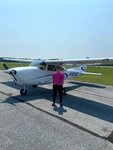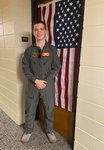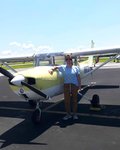


Three Battle Ground High School students have been awarded the Air Force Chief of Staff Flight Academy Private Pilot Scholarship after completing an eight week summer course.
The recipients include Brooke Kirby and Wyatt Moody, of the class of 2021, and Nathanial Davis, of the class of 2022.
A great amount of determination and training goes into being selected for the scholarship, as the recipients competed against 1,200 candidates.
“First, they have to be 17 and take an Aviation Qualification Test (AQT), which is a general exam on aviation knowledge, consisting of aeronautics, instruments, and how the plane functions,” said retired Lt. Col. Andy Woodrow, who is the senior aerospace science instructor at Battle Ground High School. “Next, they have to take a fitness test that is measured by Air Force standards. The third thing is an endorsement from me to say ‘You’re a good student, you’re focused on this very attractive opportunity, and we’re going to put you in for it.’”
Woodrow said all candidates must be part of an Air Force Junior Reserve Officer Training Corps (JROTC) program at their high school. Each scholarship is valued at $24,000 and can be used at one of 24 colleges with a flying program. Options include the University of Maryland, Purdue University and Embry-Riddle Aeronautical University.
Over the past summer, Kirby stayed at Liberty University, where she received her pilot’s license after clocking in over 45 hours plus ground school, while battling a thunderstorm in August along the way. Moody attended Indiana Wesleyan University and was the first among 16 students in his group to complete the study and flight examination. As for Davis, he attended the University of Maryland Eastern Shore, where he developed lifelong friendships in the program.
Each university, Woodrow said, had 15 to 20 students live at the college for around eight weeks. During the experience, their full-time job was to study and fly, sometimes as often as seven days a week. Those who completed the course received their pilot’s license in part due to the intensive curriculum.
A typical private pilot certificate in the United States usually requires 70 to 80 flight hours, but the students in the eight-week scholarship program received their licenses in almost half the time.
“All (the students) are doing every day from sunup to sundown is studying aviation,” Woodrow said. “Unlike someone getting a pilot’s license — like you or I going after work or on a weekend where we pick up as much as we can when we can — they’re spending 40 hours a week or more in classes or flying. Between simulator time and actual flight time, they’re really honing their skills to get their pilot certification faster than the average person.”
Although the students spent much of their summer flying and in class, the end result of obtaining a license will open many doors for them, Woodrow said.
He added the students who attend the program are not obligated to serve in the U.S. Air Force. The program intends to increase the number of pilots in the country since many are aging out of their careers or retiring, Woodrow said. A combination of retirees and the COVID-19 pandemic has led to a massive decline in the number of pilots in the country.
“In the next 12 months, we’ll find out if the payoff is reached, seeing how many students come out and say they’re joining the Air Force or commercial airlines,” Woodrow said.
Woodrow said the program is designed to select cadets who have an interest in an aviation career. The program exposes them to flying operations as well as programs and infrastructures in and around aviation.
“This is a tremendous opportunity for high school students and we are very proud of all the cadets who competed for this coveted scholarship,” Woodrow said. “While there is no obligation to join the Air Force or even become a full-time pilot after high school, this is the first step in discovering flight and possibly making a positive impact on the overall national crisis of pilot shortages in the military and civil aviation.”